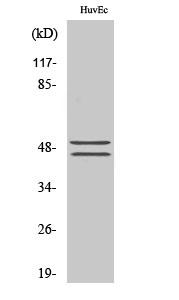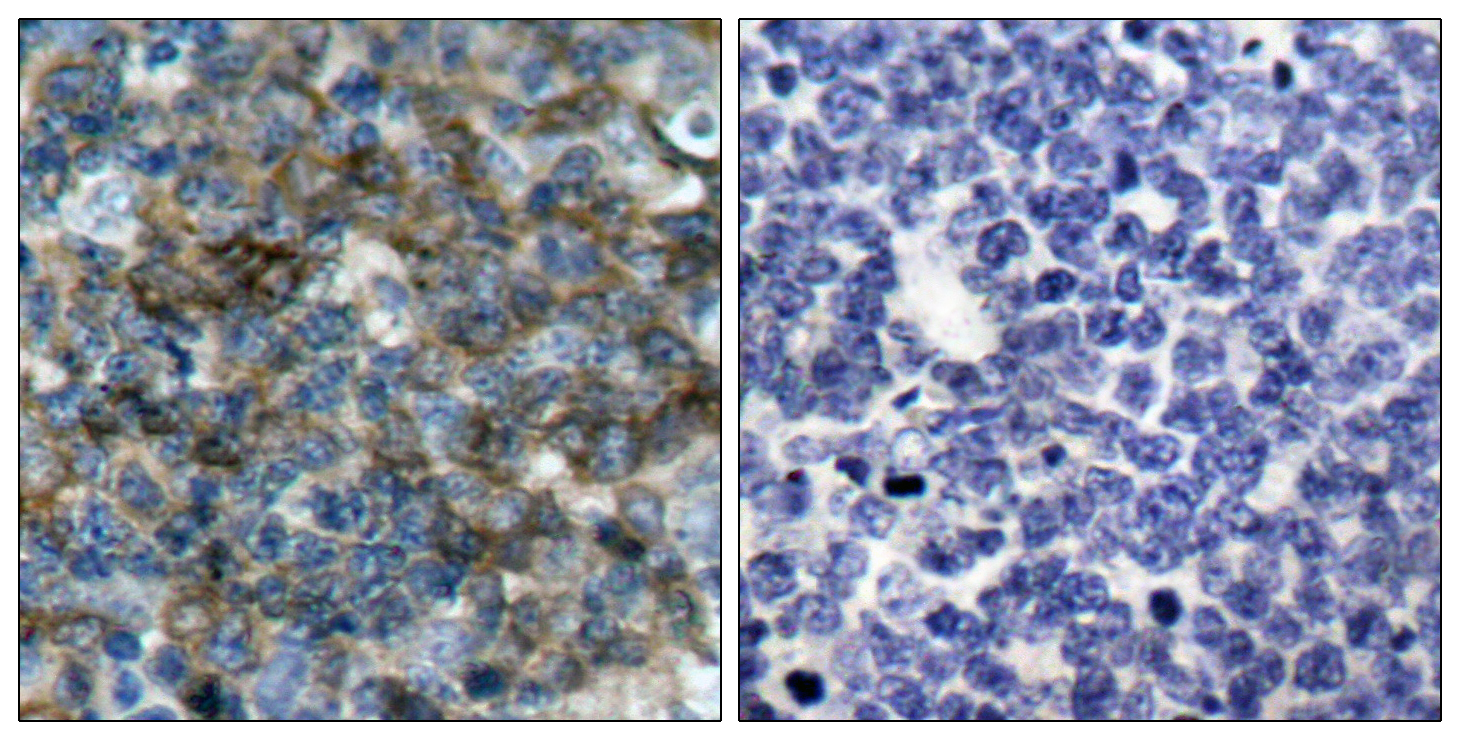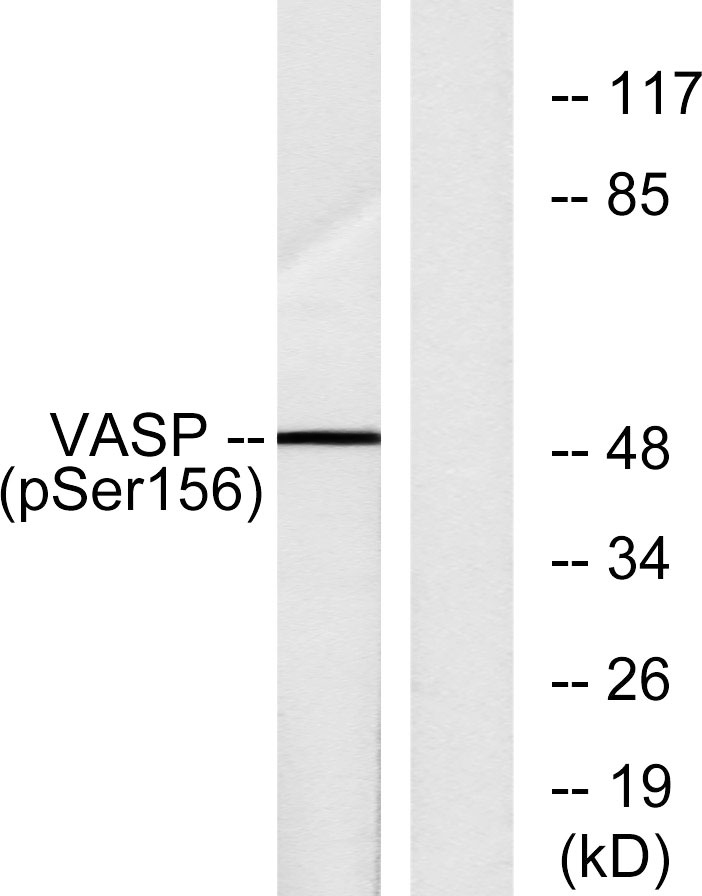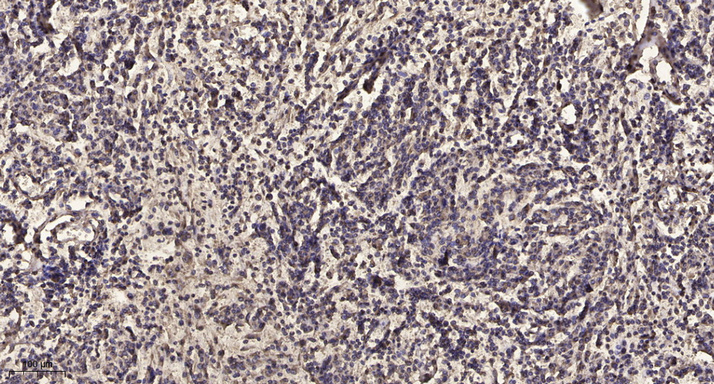VASP (phospho Ser157) Polyclonal Antibody
- Catalog No.:YP0271
- Applications:WB;IHC;IF;ELISA
- Reactivity:Human;Mouse;Rat;Monkey
- Target:
- VASP
- Fields:
- >>Rap1 signaling pathway;>>cGMP-PKG signaling pathway;>>Focal adhesion;>>Tight junction;>>Platelet activation;>>Fc gamma R-mediated phagocytosis;>>Leukocyte transendothelial migration
- Gene Name:
- VASP
- Protein Name:
- Vasodilator-stimulated phosphoprotein
- Human Gene Id:
- 7408
- Human Swiss Prot No:
- P50552
- Mouse Gene Id:
- 22323
- Mouse Swiss Prot No:
- P70460
- Immunogen:
- The antiserum was produced against synthesized peptide derived from human VASP around the phosphorylation site of Ser157. AA range:124-173
- Specificity:
- Phospho-VASP (S157) Polyclonal Antibody detects endogenous levels of VASP protein only when phosphorylated at S157.
- Formulation:
- Liquid in PBS containing 50% glycerol, 0.5% BSA and 0.02% sodium azide.
- Source:
- Polyclonal, Rabbit,IgG
- Dilution:
- WB 1:500 - 1:2000. IHC 1:100 - 1:300. ELISA: 1:5000.. IF 1:50-200
- Purification:
- The antibody was affinity-purified from rabbit antiserum by affinity-chromatography using epitope-specific immunogen.
- Concentration:
- 1 mg/ml
- Storage Stability:
- -15°C to -25°C/1 year(Do not lower than -25°C)
- Other Name:
- VASP;Vasodilator-stimulated phosphoprotein;VASP
- Observed Band(KD):
- 46kD,50kD
- Background:
- Vasodilator-stimulated phosphoprotein (VASP) is a member of the Ena-VASP protein family. Ena-VASP family members contain an EHV1 N-terminal domain that binds proteins containing E/DFPPPPXD/E motifs and targets Ena-VASP proteins to focal adhesions. In the mid-region of the protein, family members have a proline-rich domain that binds SH3 and WW domain-containing proteins. Their C-terminal EVH2 domain mediates tetramerization and binds both G and F actin. VASP is associated with filamentous actin formation and likely plays a widespread role in cell adhesion and motility. VASP may also be involved in the intracellular signaling pathways that regulate integrin-extracellular matrix interactions. VASP is regulated by the cyclic nucleotide-dependent kinases PKA and PKG. [provided by RefSeq, Jul 2008],
- Function:
- domain:The EVH2 domain is comprised of 3 regions. Block A is a thymosin-like domain required for G-actin binding. The KLKR motif within this block is essential for the G-actin binding and for actin polymerization. Block B is required for F-actin binding and subcellular location, and Block C for tetramerization.,domain:The WH1 domain mediates interaction with XIRP1.,function:Ena/VASP proteins are actin-associated proteins involved in a range of processes dependent on cytoskeleton remodeling and cell polarity such as axon guidance and lamellipodial and filopodial dynamics in migrating cells. VASP promotes actin nucleation and increases the rate of actin polymerization in the presence of capping protein. Plays a role in actin-based activity of Listeria monocytogenes in platelets.,PTM:Major substrate for cAMP-dependent (PKA) and cGMP-dependent protein kinase (PKG) in platelets. The preferred
- Subcellular Location:
- Cytoplasm. Cytoplasm, cytoskeleton. Cell junction, focal adhesion. Cell junction, tight junction . Cell projection, lamellipodium membrane. Cell projection, filopodium membrane. Targeted to stress fibers and focal adhesions through interaction with a number of proteins including MRL family members. Localizes to the plasma membrane in protruding lamellipodia and filopodial tips. Stimulation by thrombin or PMA, also translocates VASP to focal adhesions. Localized along the sides of actin filaments throughout the peripheral cytoplasm under basal conditions. In pre-apoptotic cells, colocalizes with MEFV in large specks (pyroptosomes).
- Expression:
- Highly expressed in platelets.
- June 19-2018
- WESTERN IMMUNOBLOTTING PROTOCOL
- June 19-2018
- IMMUNOHISTOCHEMISTRY-PARAFFIN PROTOCOL
- June 19-2018
- IMMUNOFLUORESCENCE PROTOCOL
- September 08-2020
- FLOW-CYTOMEYRT-PROTOCOL
- May 20-2022
- Cell-Based ELISA│解您多样本WB检测之困扰
- July 13-2018
- CELL-BASED-ELISA-PROTOCOL-FOR-ACETYL-PROTEIN
- July 13-2018
- CELL-BASED-ELISA-PROTOCOL-FOR-PHOSPHO-PROTEIN
- July 13-2018
- Antibody-FAQs
- Products Images

- Western Blot analysis of various cells using Phospho-VASP (S157) Polyclonal Antibody

- Enzyme-Linked Immunosorbent Assay (Phospho-ELISA) for Immunogen Phosphopeptide (Phospho-left) and Non-Phosphopeptide (Phospho-right), using VASP (Phospho-Ser157) Antibody

- Immunohistochemistry analysis of paraffin-embedded human tonsil, using VASP (Phospho-Ser157) Antibody. The picture on the right is blocked with the phospho peptide.

- Western blot analysis of lysates from NIH/3T3 cells treated with forskolin 40 muM 30', using VASP (Phospho-Ser157) Antibody. The lane on the right is blocked with the phospho peptide.


